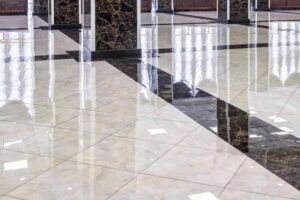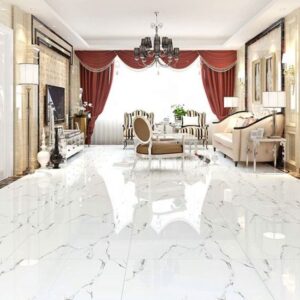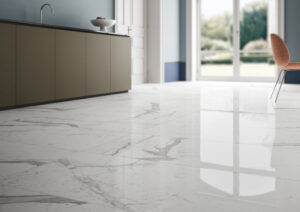Did you know that when it comes to choosing between marble, granite, or tiles for your home, there are a multitude of factors to consider?
In this article, we will explore the cost comparison, durability factors, maintenance requirements, aesthetics and design options, heat and moisture resistance, environmental impact, longevity and lifespan, stain and scratch resistance as well as their popularity and trendiness.
By examining these aspects objectively and analytically, we aim to help you make an informed decision about which option is better suited for your needs.
Key Takeaways Which Is Better Marble or Granite or Tiles
- Marble and granite have longer lifespans than most tiles.
- Granite is highly resistant to chemicals and physical impacts.
- Tiles have excellent slip resistance and are ideal for moisture-prone areas.
- Marble offers a variety of colors and patterns and adds a unique and elegant look to any space.
Cost Comparison
When comparing costs, it’s important to consider factors like installation expenses and maintenance fees.
In terms of cost effectiveness, it can be said that tiles are the most affordable option. The installation process for tiles is relatively straightforward and does not require professional assistance in most cases. This can significantly reduce the overall cost of installation.

On the other hand, marble and granite tend to be more expensive due to their higher material costs and complex installation processes. Both marble and granite require skilled professionals for proper installation, which adds to the overall expenses. Additionally, these natural stones require regular maintenance to preserve their beauty and durability, leading to additional long-term costs.
Therefore, if cost is a significant factor in your decision-making process, tiles may be the most suitable choice due to their affordability and simpler installation process.
Durability Factors
When considering the durability of different materials, it’s important to compare their material lifespan and resistance to wear and tear. By analyzing these key factors, we can make informed decisions about which materials will stand the test of time and provide long-lasting value.

Understanding the differences in material lifespan and resistance to wear and tear allows us to choose materials that will withstand daily use and maintain their quality over an extended period.
Material Lifespan Comparison
To compare the lifespan of materials like marble, granite, and tiles, you’ll find that each option has its own unique durability.

When it comes to maintenance costs, tiles generally require less regular maintenance compared to marble and granite.
However, both marble and granite have a longer lifespan than most tile options. Marble can last for several decades if properly cared for, making it a durable choice in terms of longevity. On the other hand, granite is known for its exceptional strength and can withstand heavy use over time.
In terms of sustainability benefits, all three materials are natural stones that are environmentally friendly choices. They can be recycled or repurposed after their initial use, reducing waste and promoting sustainability in construction projects.
Resistance to Wear and Tear
All three materials have their own unique durability and can withstand heavy use over time. Marble, granite, and tiles each offer different levels of resistance to wear and tear.

- Marble: Known for its elegance and timeless beauty, marble is a durable material that can resist scratches and stains. However, it is more susceptible to chemical damage compared to granite or tiles.
- Granite: With its natural strength and hardness, granite is highly resistant to chemicals and physical impacts. It can withstand heavy foot traffic without losing its luster or color.
- Tiles: Tiles are popular for their versatility and low maintenance. They have excellent slip resistance due to their textured surface, making them ideal for areas prone to moisture like bathrooms or kitchens.
When considering resistance to chemicals and slip resistance, both granite and tiles outperform marble in various aspects.
Maintenance Requirements
You’ll find that maintaining marble requires more effort compared to granite or tiles. When it comes to maintenance cost, marble tends to be the most expensive option. It is a porous material, which means it can easily absorb liquids and stains. To keep your marble looking beautiful, you’ll need to seal it regularly to prevent damage from spills and moisture.
Cleaning techniques for marble also require special care. Harsh chemicals and abrasive cleaners can etch the surface of the stone, so it’s best to use mild soap and warm water for regular cleaning. Additionally, avoiding acidic substances like vinegar or lemon juice is crucial as they can cause permanent damage.
Overall, while marble adds elegance to any space, its high maintenance requirements make granite or tiles a more practical choice for those seeking low-cost upkeep and easy cleaning.
Aesthetics and Design Options
Maintaining marble requires more effort compared to other materials, but it offers a unique and elegant look for any space. Marble has been a popular choice in interior design for centuries due to its timeless beauty and versatility. Here are some key design options and aesthetic appeals of marble:
- Variety of colors and patterns: Marble comes in a wide range of colors, from classic white to rich shades of black, gray, green, and even pink. Its natural veining adds depth and character to any surface.
- Luxurious feel: The smooth texture and glossy finish of marble create a sense of luxury and sophistication. It can instantly elevate the aesthetic appeal of any room or surface.
- Classic elegance: Marble has stood the test of time as a symbol of opulence and refinement. Its timeless appeal ensures that it will never go out of style.
Heat and Moisture Resistance
To protect your marble surfaces from heat and moisture damage, it is important to use trivets or coasters for hot items and wipe up any spills immediately.
Marble has good heat resistance, meaning it can withstand high temperatures without getting damaged. However, it is still recommended to use protective measures like trivets to prevent any potential harm.
When it comes to moisture resistance, marble is not as resilient as granite or tiles. It can absorb liquids if left unattended for too long, leading to staining or discoloration. Therefore, it’s crucial to clean up spills promptly to minimize the risk of damage.
If you’re concerned about moisture resistance, granite or tiles may be better options as they are more resistant to water penetration and stains.
Installation Considerations
During installation, it’s important to consider factors like the weight and fragility of the marble. Proper installation techniques and best practices ensure a successful outcome. Here are three key considerations:
- Subfloor preparation: Before installing marble, it is crucial to ensure that the subfloor is properly prepared. This includes checking for any unevenness or cracks and addressing them before laying the marble tiles.
- Adhesive selection: Choosing the right adhesive is essential for a durable and long-lasting installation. The adhesive should be specifically designed for use with marble and provide strong bonding capabilities.
- Grouting: Proper grouting techniques are vital to achieve a professional finish. It is important to choose a grout color that complements the marble tiles and follow manufacturer guidelines for application.
Environmental Impact
Consider the environmental impact of your marble installation by choosing adhesives and grouts that are eco-friendly and minimize harm to the planet. When it comes to the environmental impact, both marble and granite have similar characteristics. They are natural stones that require quarrying, which can lead to habitat destruction and loss of biodiversity. However, compared to tiles, marble and granite have a higher carbon footprint due to their extraction process.
In terms of cost comparison, tiles are generally more affordable than marble or granite. The production process for tiles is simpler and less labor-intensive, resulting in lower prices. Additionally, maintenance costs should also be taken into consideration. Marble and granite require regular sealing and polishing to maintain their appearance, while tiles may only need occasional cleaning.
Ultimately, when deciding between marble, granite, or tiles for your installation project, it’s important to weigh the environmental impact against your budgetary constraints. Consider opting for eco-friendly materials whenever possible while also taking cost factors into account.
Longevity and Lifespan
When considering the longevity and lifespan of materials for construction or home improvement projects, two key points to consider are durability and maintenance requirements.
Durability refers to how well a material can withstand wear and tear over time. This includes factors such as resistance to weathering, impact, and degradation. Materials with high durability will last longer and require fewer repairs or replacements.
On the other hand, maintenance requirements refer to the level of care and upkeep needed to keep the material in good condition. Some materials may require regular cleaning, sealing, or painting to maintain their appearance and performance. Others may be more resistant to stains, fading, or other forms of damage, requiring less maintenance.
Durability of Materials
You’ll want to think about how durable the materials are before making a decision on whether marble, granite, or tiles are better. Material strength and impact resistance are crucial factors to consider when evaluating the durability of these options:
- Marble: While elegant and visually appealing, marble is not as strong as granite or tiles. It is prone to scratching and can chip easily upon impact.
- Granite: Known for its exceptional strength, granite is highly resistant to scratches and impacts. It can withstand heavy use without showing signs of wear and tear.
- Tiles: Tiles come in various materials such as ceramic, porcelain, or natural stone. They offer good durability with high impact resistance. However, it’s important to choose high-quality tiles that can withstand heavy foot traffic.
Maintenance Requirements
Maintaining the durability of your chosen material is essential for long-term use and enjoyment. When it comes to maintenance, both marble and granite require regular care to keep them looking their best.
Marble is more porous than granite, making it more susceptible to stains and scratches. To prevent this, sealing the marble surface every few months is recommended.
Granite, on the other hand, requires less frequent sealing due to its lower porosity. Both materials can be cleaned using mild soap and water or a stone-specific cleaner.
As for maintenance costs, they will vary depending on the size of the area and any specific issues that may arise. Ensuring proper cleaning methods and investing in regular professional maintenance can help prolong the lifespan of your chosen material.
Moving onto stain and scratch resistance…
Stain and Scratch Resistance
Granite countertops are known for their excellent stain and scratch resistance. With its natural composition, granite is inherently resistant to stains caused by spills of common household items like wine, oil, and coffee. Its dense and durable surface also makes it highly resistant to scratches from knives, pots, and pans.
- Stain Resistance: Granite’s low porosity prevents liquids from seeping into the stone, making it resistant to staining.
- Scratch Resistance: The hardness of granite makes it difficult to scratch or chip. It can withstand daily use without showing signs of wear and tear.
- Sealing: While granite is naturally resistant to stains, periodic sealing can enhance its stain resistance even further.
These qualities make granite an ideal choice for high-traffic areas like kitchens and bathrooms where durability is essential. Additionally, the stain and scratch resistance of granite countertops ensure that they maintain their beauty and functionality for years to come.
Popularity and Trendiness
When it comes to choosing materials for our homes, there are several key factors that influence our decisions.
Consumer preferences and demand play a crucial role in determining which materials are popular and trendy.
Design and aesthetics also come into play, as we strive for a visually appealing space.
Additionally, long-term value and durability are important considerations, ensuring that the chosen materials will stand the test of time.
In this discussion, we will delve into these three key points to understand how they shape our choices in home design.
Consumer Preferences and Demand
If you’re looking for a durable and stylish option, marble might be the perfect choice for your home. Consumer preferences and demand for marble have been on the rise in recent years.
Here are three reasons why:
- Timeless appeal: Marble has been used in architecture and design for centuries, giving it a timeless quality that appeals to many homeowners.
- Variety of colors and patterns: Marble comes in a wide range of colors and patterns, allowing consumers to find the perfect match for their desired aesthetic.
- Long-lasting durability: With proper care and maintenance, marble can last a lifetime. Its durability makes it an attractive choice for high-traffic areas like kitchens or bathrooms.
As consumer preferences shift towards more elegant and sophisticated designs, marble continues to be a popular choice.
Now let’s explore how marble compares to granite in terms of design and aesthetics.
Design and Aesthetics
As homeowners seek a more refined and elegant look, marble’s timeless appeal and variety of colors make it an attractive choice for design and aesthetics. Marble offers a range of design options that can complement any style or trend. From classic white Carrara to exotic Calacatta Gold, the color options are endless. To illustrate this point, here is a table showcasing some popular marble colors:
| Color | Description | Usage |
|---|---|---|
| White Carrara | Classic white with grey veins | Bathroom countertops |
| Emperador | Brown with light veining | Fireplace surrounds |
| Calacatta Gold | Creamy white with gold veins | Kitchen backsplashes |
| Statuario | White with dramatic grey veining | Flooring |
| Nero Marquina | Black with white veins | Accent walls |
Marble’s versatility allows designers to incorporate it into various areas of the home, from kitchens to bathrooms. It adds elegance and sophistication while staying true to current design trends. With its wide array of color options, marble remains a top choice for homeowners looking to elevate their interior spaces.
Long-Term Value and Durability
To ensure long-term value and durability, it’s important to follow a few guidelines for sealing and maintaining marble surfaces. Marble, being a natural stone, can last for decades if cared for properly. However, it may require more maintenance compared to granite and tiles due to its porous nature. With proper sealing and regular maintenance, though, marble can maintain its beauty and functionality over time.
When comparing the longevity of these materials, it’s worth noting that both granite and tiles are also durable options. Granite, known for its strength, is resistant to scratches, heat, and stains. Tiles, available in materials like ceramic or porcelain, offer varying levels of durability based on their composition.
In terms of material durability, all three options have their strengths and weaknesses. Marble, for instance, requires sealing but can withstand everyday use when properly maintained. Granite, on the other hand, is highly resistant to wear and tear but may need periodic resealing. Tiles, depending on their material composition, generally offer good resistance against moisture and stains.
To summarize, here are the key points for maintaining these surfaces:
- Regular sealing of marble surfaces
- Proper cleaning techniques
- Periodic resealing for granite
Frequently Asked Questions
Are There Any Specific Types of Marble or Granite That Are More Resistant to Stains and Scratches?
There are specific types of marble and granite that are more resistant to stains and scratches. When comparing maintenance requirements, it is important to consider the durability and sealing options for each material.
Can Tiles Be Used for Outdoor Applications or Are They Only Suitable for Indoor Use?
Tiles can be used for outdoor applications, but they have pros and cons. They are durable and easy to clean, but can be slippery when wet. It’s important to choose the right type of tile for outdoor use.
What Are Some Alternative Options to Marble, Granite, and Tiles for Countertops and Flooring?
When considering alternative materials for countertops and flooring, it’s important to weigh the pros and cons of using marble, granite, or tiles. Some options to consider include quartz, concrete, and laminate.
How Do the Maintenance Requirements for Marble, Granite, and Tiles Compare to Other Popular Countertop and Flooring Materials?
When it comes to comparing the maintenance requirements of marble, granite, and tiles with other popular countertop and flooring materials, we can delve into their pros and cons.
Are There Any Health or Safety Concerns Associated With Using Marble, Granite, or Tiles in Residential or Commercial Spaces?
When considering marble, granite, or tiles for residential or commercial spaces, it’s important to be aware of potential health concerns and safety considerations. Understanding the risks associated with these materials is crucial for making informed decisions.
Conclusion
Overall, when comparing marble, granite, and tiles, it is clear that each option has its own advantages and disadvantages. However, one interesting statistic to note is that according to a recent study, marble has become increasingly popular in home renovations, with a 17% increase in demand over the past year.
This may be due to its timeless beauty and luxurious appearance. Ultimately, the choice between these materials will depend on personal preferences and specific needs. Whether you prioritize cost-effectiveness or durability, it’s important to carefully consider all factors before making a decision.




